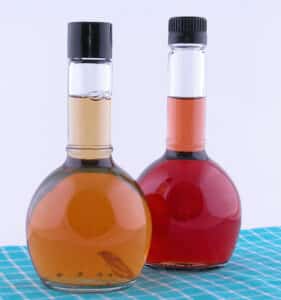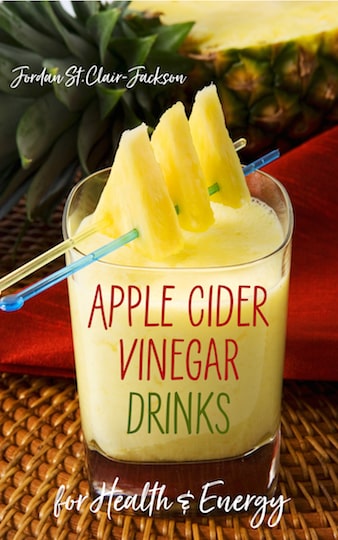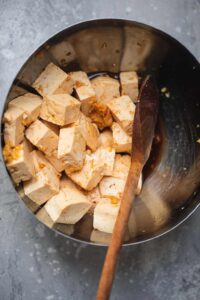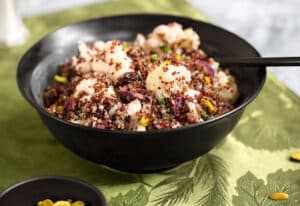Vinegar, from the French words vin (“wine”) and aigre (“sour”), has been made since ancient times by fermenting various liquids. There are numerous types of vinegar, from the cheap, harsh white distilled vinegar to precious varieties, such as well-aged balsamic vinegar that can cost up to one hundred dollars a bottle. Here's a brief overview of just a handful of vinegars—those most commonly found in natural-food stores or those that are common to ethnic cuisines popular in the wholefoods realm.
A fine vinegar doesn’t have to be terribly expensive to be good and, used even in minute amounts, can do wonders to wake up the flavors of foods. Vinegars add a zest that helps reduce the need for salt.
Apple Cider Vinegar
Made from apple cider, this all-time favorite (often referred to ACV) is mellower than distilled vinegar, yet its tart-sweet flavor is sharp enough to make a statement in dressings, marinades, and pickling, as well as directly on salads. There are varying grades of apple cider vinegar. For superior quality, look for one that's raw, unfiltered and organic, such as Bragg. For lots more info on ACV see our posts on the Apple Cider Vinegar Diet and 23 Researched-Backed Benefits of ACV.
Balsamic Vinegar
An aged, sweet-wine vinegar, the mellow flavor of balsamic vinegar is welcome anywhere a mild vinegar flavor is desired—with salads of mild greens, in light vinaigrette marinades or dressings, or just dashed on freshly steamed vegetables. Dark brown in color, balsamic vinegar is made of grapes with a high sugar content. Its flavor is so mellow that you might even like to splash it on fruit salad. Though usually very expensive, balsamic vinegar will go a long way.
Champagne Vinegar
This vinegar is light and flavorful and has a taste similar to champagne, as it is produced using the same type of grapes. It is created by the same basic process that is used in making white vinegar and apple cider vinegar. It adds an exciting flavor to salads and vegetables. When mixed with a sweetener it is great on salads and when mixed with herbs and spices is a fantastic marinade. It can be used in almost any recipe to enhance flavor and it can also be mixed with other vinegars, especially those with a slightly fruity taste.
Coconut Vinegar
Made from either the sap of a coconut tree or fermented coconut water, this vinegar is used extensively in Southeast Asian (especially the Phillipines) and in some Indian cuisines. Made naturally and with no artificial additives, this inexpensive vinegar is packed with vitamins and minerals. It is cloudy and white with a sharp, acidic taste with a hint of yeast, and can be used on salads or for pickling. When mixed with spices it can transform into an exciting table sauce for dipping.
Herb Vinegars
These gourmet-quality vinegars are flavored with fresh herbs, such as tarragon, basil, or mixed herbs. Exceptionally flavorful, they are superb used directly on fresh salads or to marinate salads. Try splashing a bit over freshly steamed vegetables to reduce the need for salt.
Malt Vinegar
This vinegar is fermented from barley malt; it has a deep-amber color and a very distinct, sharp flavor that many will find too strong for salads. Try it in potato salads, pickles, chutneys, grilling sauces, and in recipes using strong-flavored sea vegetables such as hijiki.
Rice Vinegar
Once you try rice vinegar, you may never want to use ordinary white vinegar again. Rice vinegar is subtle, fragrant, and just slightly sweet. Good-quality rice vinegar is extracted from the first pressing of fermented rice. Its most traditional use is as a seasoning for short-grain rice used in making sushi, but is it welcome almost anywhere a mild vinegar is needed.
In Asian groceries, the rice vinegar sold is usually white. The kind sold in natural-food stores is usually brown rice vinegar; there's also sweet brown rice vinegar, the latter being the mellowest of the three. They’re all excellent, with only slight differences in flavor. Rice vinegar is widely used as an ingredient in soy-based dipping sauces. It is also good in marinades and dressings, or in pickling. A splash of it added to a simple brown-rice-and-vegetable dish or noodle stir-fries will impart a subtle zest.
Sherry Vinegar
Made in Spain in an area know as the “sherry triangle”, this gourmet wine vinegar has a deep, complex flavor that is smooth, yet potent. Made from Sherry it must be aged in oak for at least six months within the “sherry triangle.” It can be used in a variety of dishes such as soups, stews, sauces, casseroles and dressings.
Umeboshi Vinegar
With the same sour and salty flavor of the plums, this liquid is derived from the pickling of ume plums. Use it as you would any other vinegar—in salad dressings, marinades, and pickles—but do so sparingly, since its powerful flavor goes a long way.
A great way to learn to love ACV!
Apple Cider Vinegar Drinks for Health & Energy
Enjoy the Benefits of ACV with Tonics, Mocktails, and smoothies with 25 Easy Recipes
Now available for Kindle (can be read on any device)
- For lots more features on healthy lifestyle, explore VegKitchen’s Healthy Vegan Kitchen page.
- Here are more of VegKitchen’s Natural Food Guides.








Comments
No Comments